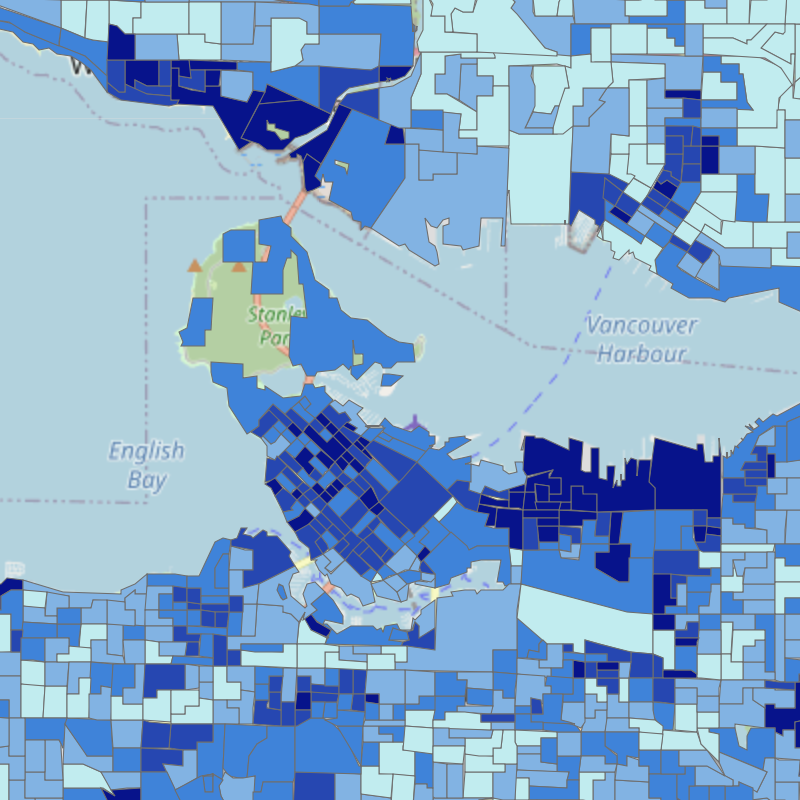Human Settlement and Natural Hazards in Canada
The NHSL is a collection of datasets that describe the physical and social characteristics of communities across Canada in the context of their vulnerability to natural hazards. This information is intended to be used as baseline inputs to natural hazards risks assessments where such information is unavailable. The purpose is to support implementation of the Sendai Framework for Disaster Risk Reduction at the local, regional, and national scales.
Information is currently disseminated in the Physical Exposure and Social Fabric components of the NHSL. The Physical Exposure component includes a delineation of settled areas and related land use across Canada, as well as information about buildings, persons, and building replacement values (structure and contents) within those areas. The Social Fabric component of the NHSL includes information about broad spatial patterns of social vulnerability at the neighbourhood scale, and indicators about the capacities for a community to withstand and recover from disaster events based on characteristics of housing, family structure, individual autonomy and financial agency.
The Geological Survey of Canada, through the Public Safety Geoscience Program, has developed these datasets. Please direct any questions about the NHSL layers to Philip LeSueur at philip.lesueur@nrcan-rncan.gc.ca or Nicky Hastings at nicky.hastings@nrcan-rncan.gc.ca.
All products are released under the Open Government Licence - Canada.
-
Organization name:
Government of Canada;Natural Resources Canada;Lands and Minerals Sector, Geological Survey of Canada -
Email:
GSC.info.CGC@NRCan.gc.ca
Physical Exposure
The Physical Exposure component of the National Human Settlement Layer (NHSL), defined here as the ‘Physical Exposure Model’, includes a delineation of settled areas and related land use across Canada, as well as information about buildings, persons, and building replacement values (structure and contents) within those areas.
Buildings within the inventory are classified using a combination of occupancy types, engineering-based construction types adopted for Canada, and design levels representing the approximate building code requirements at the time of construction. The inventory is derived from detailed housing statistics provided at the dissemination block level as part of the 2016 national census and from georeferenced business listings. Building populations at different times of day are estimated for standard daytime hours (9am-5pm); for morning and evening commute hours (7am-9am; 5pm-7pm), and; for nighttime hours when the majority of people are home (7pm-7am). Replacement values are provided for structural, nonstructural, and contents components of buildings, based on industry replacement costs for representative regions across Canada.
In total, the model characterizes 35.2 million people in 9.7 million buildings across 390,000 locations with a total approximate replacement value of $8.2 trillion (2019 CAD) including contents.
Data Resources
National Scale
| Resource Name | Format | Links | |
|---|---|---|---|
| Physical Exposure - Overview | Document | Access | |
| Physical Exposure Full Report | Document | Access | |
| Physical Exposure polygon geometry (Canada) | Web Service | ESRI REST | Access |
| Physical Exposure polygon geometry (Canada) | Web Service | HTML | Access |
| Physical Exposure point geometry (Canada) | Web Service | HTML | Access |
| Physical Exposure polygon geometry (Canada) | Dataset | GPKG | Access |
| Physical Exposure point geometry (Canada) | Dataset | GPKG | Access |
| Data dictionary | Document | EXCEL | Access |
Regional Scale
| Resource Name | Format | Links | |
|---|---|---|---|
| Physical Exposure polygon geometry (AB) | Dataset | GPKG | Access |
| Physical Exposure point geometry (AB) | Dataset | GPKG | Access |
| Physical Exposure polygon geometry (BC) | Dataset | GPKG | Access |
| Physical Exposure point geometry (BC) | Dataset | GPKG | Access |
| Physical Exposure polygon geometry (MB) | Dataset | GPKG | Access |
| Physical Exposure point geometry (MB) | Dataset | GPKG | Access |
| Physical Exposure polygon geometry (NB) | Dataset | GPKG | Access |
| Physical Exposure point geometry (NB) | Dataset | GPKG | Access |
| Physical Exposure polygon geometry (NL) | Dataset | GPKG | Access |
| Physical Exposure point geometry (NL) | Dataset | GPKG | Access |
| Physical Exposure polygon geometry (NS) | Dataset | GPKG | Access |
| Physical Exposure point geometry (NS) | Dataset | GPKG | Access |
| Physical Exposure polygon geometry (NT) | Dataset | GPKG | Access |
| Physical Exposure point geometry (NT) | Dataset | GPKG | Access |
| Physical Exposure polygon geometry (NU) | Dataset | GPKG | Access |
| Physical Exposure point geometry (NU) | Dataset | GPKG | Access |
| Physical Exposure polygon geometry (ON) | Dataset | GPKG | Access |
| Physical Exposure point geometry (ON) | Dataset | GPKG | Access |
| Physical Exposure polygon geometry (PE) | Dataset | GPKG | Access |
| Physical Exposure point geometry (PE) | Dataset | GPKG | Access |
| Physical Exposure polygon geometry (QC) | Dataset | GPKG | Access |
| Physical Exposure point geometry (QC) | Dataset | GPKG | Access |
| Physical Exposure polygon geometry (SK) | Dataset | GPKG | Access |
| Physical Exposure point geometry (SK) | Dataset | GPKG | Access |
| Physical Exposure polygon geometry (YT) | Dataset | GPKG | Access |
| Physical Exposure point geometry (YT) | Dataset | GPKG | Access |
Social Fabric
The Social Vulnerability component of the National Human Settlement Layer (NHSL) includes information about broad spatial patterns of social vulnerability at the neighbourhood scale, and indicators about the capacities for a community to withstand and recover from disaster events based on intrinsic characteristics of housing, family structure, individual autonomy and financial agency.
Report a problem on this page
- Date modified:

